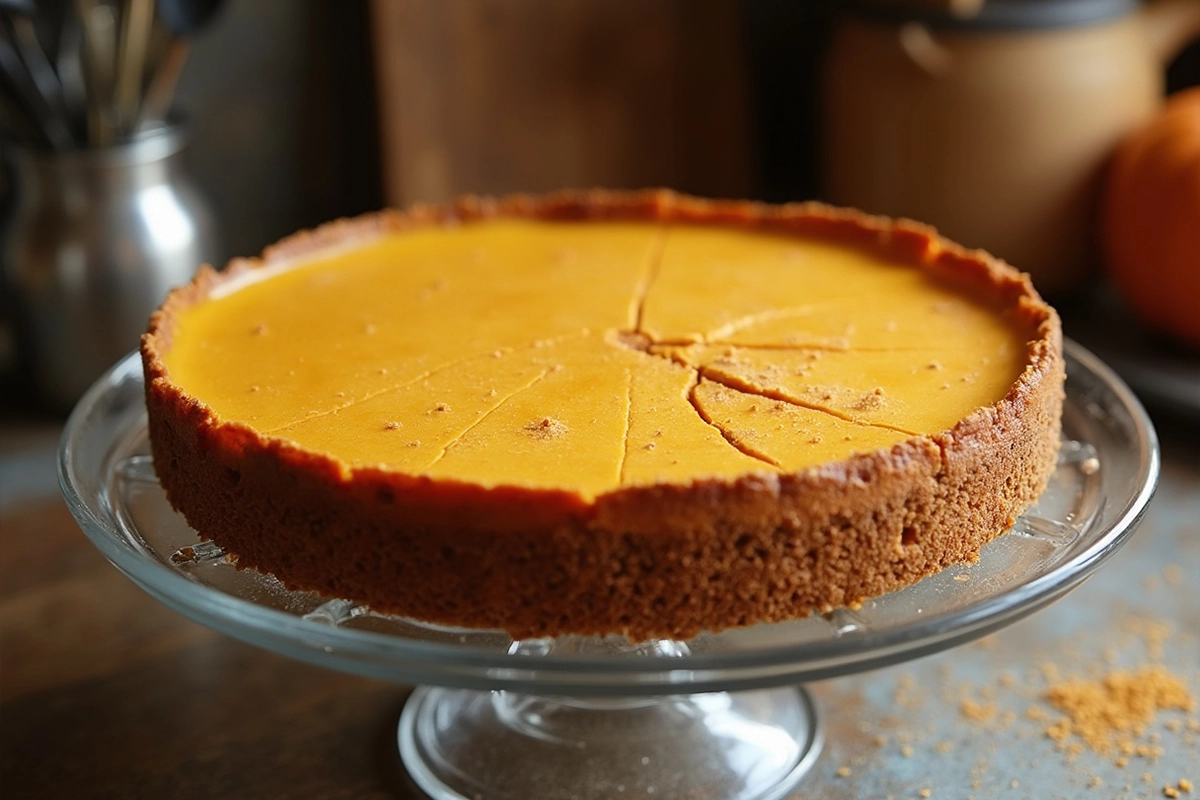Baking a perfect pumpkin cheesecake can feel like an art form, especially when you’re trying to avoid those dreaded cracks that often form across its smooth, creamy surface. Many home bakers find themselves puzzled after following a recipe, only to see their cheesecake crack once it cools. What causes pumpkin cheesecake to crack, and how can you prevent it? You’re not alone if you’ve asked yourself this question.
In this article, we will explore what causes pumpkin cheesecake to crack and provide practical solutions to help you avoid this common baking issue. Whether you’re an experienced baker or trying your hand at cheesecake for the first time, this guide will help you achieve a flawless, crack-free pumpkin cheesecake.
For more creative pumpkin dessert ideas, you might also want to try these delicious pumpkin cheesecake cookies, which combine the best of both pumpkin and cheesecake flavors! According to Sally’s Baking Addiction, one of the most common culprits of cracked cheesecakes is overbaking. But that’s not the only issue. As Taste of Home suggests, using a water bath is a great way to prevent cracking by maintaining an even baking temperature. Let’s dive deeper into what causes pumpkin cheesecake to crack and how to avoid these problems.
Common Causes of Cracks in Pumpkin Cheesecake
Overbaking
Overbaking is by far the most common cause of cracks in cheesecake. As the cheesecake bakes, the heat causes the proteins in the eggs to coagulate and set. If left in the oven too long, the cheesecake becomes too dry, leading to cracks on the surface. Cheesecake should be removed from the oven while it’s still slightly jiggly in the center because the residual heat will continue to cook the cake. This is a key factor in understanding what causes pumpkin cheesecake to crack.
Temperature Fluctuations
Rapid temperature changes are another major cause of cracking. When a pumpkin cheesecake cools too quickly, the outside cools faster than the center. This uneven cooling causes the surface to shrink before the center has fully set, leading to cracks. Avoid removing the cheesecake immediately from the oven; instead, allow it to cool gradually by leaving the oven door slightly ajar after baking.
Overmixing the Batter
Incorporating too much air into the batter can cause your cheesecake to crack. Overmixing introduces air bubbles that expand in the oven, causing the cheesecake to rise and then collapse as it cools. This rise-and-fall effect often leads to surface cracks. To avoid this, mix your ingredients on low speed and avoid overbeating the eggs, another common reason behind what causes pumpkin cheesecake to crack.
Using High Heat
Baking at too high of a temperature can cause the cheesecake to set too quickly, leading to cracks. A slow and low-temperature bake is essential for pumpkin cheesecake. High heat can cause the cheesecake to puff up and then crack as it cools and settles. Always bake your cheesecake at the recommended temperature, and don’t be tempted to increase the heat to speed up the process.
The Role of Ingredients in Cheesecake Cracking
Eggs and Protein Structure
Eggs play a crucial role in setting the structure of your pumpkin cheesecake. The proteins in the eggs coagulate as the cheesecake bakes, providing stability to the custard. However, if the eggs are overcooked, they cause the cheesecake to dry out and crack. It’s essential to monitor the baking time closely and remove the cheesecake when the edges are set but the center is still slightly jiggly.
Pumpkin Puree and Moisture Balance
Pumpkin adds a significant amount of moisture to the cheesecake batter, and this moisture must be carefully balanced. Too much moisture can make the cheesecake too loose, leading to uneven baking and potential cracks. On the other hand, if there isn’t enough moisture, the cheesecake can dry out. Using the right amount of pumpkin puree and balancing it with other ingredients like cream cheese ensures the right texture and reduces the risk of cracking.
Dairy and Cream Cheese Quality
The quality and temperature of your cream cheese are also essential to preventing cracks. Cold cream cheese can lead to lumpy batter, which may not bake evenly. Always use room-temperature cream cheese to ensure a smooth and creamy batter that bakes evenly. Poorly mixed ingredients can lead to uneven baking, which contributes to cracks.
Best Baking Practices to Avoid Cracks
Water Bath Technique (Bain-Marie)
One of the most effective methods for preventing cracks in a cheesecake is using a water bath. The water bath helps bake the cheesecake evenly by surrounding the pan with steam, which regulates the temperature. Here’s how to do it:
- Wrap the outside of your springform pan with two layers of aluminum foil to prevent water from seeping into the cheesecake.
- Place the wrapped pan in a large roasting pan.
- Fill the roasting pan with hot water, enough to reach halfway up the sides of the springform pan.
- Bake the cheesecake as instructed, checking it for doneness while keeping the oven temperature steady.
This method ensures that the cheesecake bakes evenly, preventing the surface from cracking.
Avoiding Overmixing
Mixing your ingredients on low speed is key to preventing air bubbles in the batter. If you’re using a stand mixer, use the paddle attachment on a low setting to mix the cream cheese and sugar until just combined. Be particularly gentle when adding the eggs, as overmixing can lead to an overly aerated batter that is prone to cracking.
Using Low and Slow Baking Temperatures
Baking your cheesecake at a low temperature is crucial to avoid cracks. Pumpkin cheesecake is especially delicate, and a slow, even bake is essential for setting the custard properly without overcooking it. Avoid using high heat, which can cause the edges to overbake while leaving the center undercooked, leading to cracks.
Gradual Cooling
Letting your cheesecake cool slowly is vital to avoid temperature shock, which can cause cracks. When the baking time is up, turn off the oven and let the cheesecake sit inside with the door slightly ajar for about an hour. This allows the cheesecake to cool gradually without the sudden drop in temperature that leads to cracking. Afterward, transfer the cheesecake to a cooling rack and allow it to come to room temperature before refrigerating.
How to Fix a Cracked Pumpkin Cheesecake
Masking with Toppings
If your cheesecake does crack, don’t worry—you can still make it look beautiful with toppings. Here are some creative ways to cover the cracks:
- Whipped Cream: A layer of whipped cream can hide any imperfections while adding a light, airy contrast to the rich cheesecake.
- Fruit Toppings: Fresh berries or a fruit compote not only cover cracks but also add a burst of flavor and color.
- Caramel or Chocolate Drizzle: A simple drizzle of caramel or chocolate sauce can easily disguise cracks and give the cheesecake a polished look.
Filling the Cracks
For a quick fix, you can fill the cracks with a bit of softened cream cheese. Use a spatula to gently smooth the cream cheese into the cracks, making the surface appear more even. Once filled, you can chill the cheesecake to help the cream cheese set.
Preventative Tips for Next Time
If your cheesecake cracks this time, don’t get discouraged. It’s common, and with a few adjustments to your technique, you can avoid cracks in the future. Remember to use a water bath, avoid overmixing, and cool the cheesecake gradually.
Expert Tips from Professional Bakers
Many professional bakers recommend the following tips for a crack-free pumpkin cheesecake:
- Use a Springform Pan: Springform pans allow for even baking and easy removal of the cheesecake without disturbing the delicate structure.
- Don’t Overbake: Remove the cheesecake from the oven when the center is still slightly jiggly. It will continue to set as it cools.
- Room Temperature Ingredients: Ensure all ingredients, especially cream cheese, eggs, and pumpkin puree, are at room temperature before mixing to ensure a smooth batter and even baking.
Common Mistakes to Avoid
- Skipping the Water Bath: Many home bakers skip the water bath, thinking it’s unnecessary, but this is one of the best methods for ensuring even baking.
- Opening the Oven Door Too Often: Avoid opening the oven door frequently during baking, as this can cause temperature fluctuations that lead to cracking.
FAQs Based on “People Also Ask”
Why Does My Pumpkin Cheesecake Crack?
Cracking is usually caused by overbaking, rapid temperature changes, or overmixing the batter. Using a water bath and cooling the cheesecake gradually helps prevent cracks.
How Can I Stop My Cheesecake From Cracking?
To prevent your cheesecake from cracking, avoid overbaking, use a water bath, and cool the cheesecake slowly. Also, mix the batter gently to prevent air bubbles from forming.
Can You Fix a Cracked Cheesecake?
Yes, you can fix a cracked cheesecake by filling the cracks with softened cream cheese or by masking the cracks with toppings like whipped cream, fruit, or a caramel drizzle.
Does Overmixing Cause Cheesecake to Crack?
Yes, overmixing can introduce air bubbles into the batter, which cause the cheesecake to rise and then crack as it cools.
Should You Use a Water Bath for Pumpkin Cheesecake?
Using a water bath is one of the best ways to prevent cracking. It helps regulate the temperature and ensures even baking.
What Temperature Should You Bake Cheesecake To Prevent Cracking?
Bake your cheesecake at a low temperature, usually around 325°F, to ensure it sets slowly and evenly without cracking.
Conclusion
Cracking in a pumpkin cheesecake is a common issue that many bakers face, but with the right techniques, it can easily be avoided. Remember, overbaking, temperature changes, and overmixing are the main culprits, but with simple solutions like using a water bath and cooling the cheesecake gradually, you can prevent cracks from forming. And even if cracks do appear, there are creative ways to fix and decorate your cheesecake so it still looks perfect for your gathering.
By following these guidelines, you’ll be well on your way to mastering the art of baking a perfect, crack-free pumpkin cheesecake.

